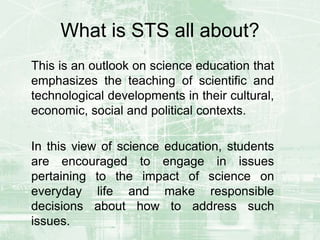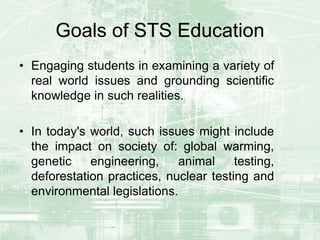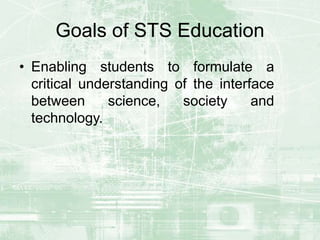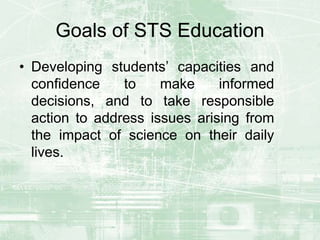STS An Introduction and its Perpectives.ppt
- 3. Science ? A body of knowledge or facts. ? A way of thinking about or approaching a topic. ? Asks questions that aim to increase our understanding of the physical universe and our ability to explain nature.
- 4. Technology ? Applied science. ? A topic involving the designing and use of devices, processes, and materials to solve practical problems and to satisfy human needs and wants.
- 5. Society ? A group, large or small, of people in a particular place and time who are linked by common goals and interests.
- 6. Environment ? The natural world or ecosystem. ? The area in which something exists or lives. ? The complex of physical, chemical, and biological factors in which a living organism or community exists.
- 7. What is STS all about? This is an outlook on science education that emphasizes the teaching of scientific and technological developments in their cultural, economic, social and political contexts. In this view of science education, students are encouraged to engage in issues pertaining to the impact of science on everyday life and make responsible decisions about how to address such issues.
- 8. Goals of STS Education ? Engaging students in examining a variety of real world issues and grounding scientific knowledge in such realities. ? In today's world, such issues might include the impact on society of: global warming, genetic engineering, animal testing, deforestation practices, nuclear testing and environmental legislations.
- 9. Goals of STS Education ? Enabling students to formulate a critical understanding of the interface between science, society and technology.
- 10. Goals of STS Education ? Developing students¡¯ capacities and confidence to make informed decisions, and to take responsible action to address issues arising from the impact of science on their daily lives.
- 11. Science, Technology, and Society Objectives: 1. Develop rationale including technology and social perspectives in science classroom 2. Explain how technology is related to science/society 3. Describe how studying technological devices can become an integral part of science instruction 4. Describe strategies for teaching STS 5. Discuss teaching controversial topics such as evolution
- 12. I. Rationale for teaching STS A. Science and Technology have profound effects on society 1. Provides products that increase quality of life 2. Negative effects of weapons, pollution, etc¡ 3. Students will live in an increasingly technological society and therefore need to understand how these institutions interact 4. We can make science instruction relevant to students a. Personal experience and societal context for lessons b. AIDS, obesity, water quality, national defense, etc¡ c. Our students will have to make informed decisions about these issues B. The STS approach to science instruction 1. Science for meeting personal needs 2. Science for addressing societal issues and problems 3. Science for assisting with career choices C. National and local standards 1. National Science Education Standards 2. Benchmarks for Scientific Literacy
- 13. II. What is Technology A. Descriptions 1. Involves the design or products, systems, and processes that affect the quality of life, using the knowledge of science when necessary 2. An applied enterprise concerned with producing appliances, tools, machines, and techniques 3. Products are called inventions B. Examples 1. Simple tools for hunting, fishing, or farming 2. Computers, satellites, airplanes C. Engineers 1. Design and produce products using science 2. Must know about the business they are working for as well as the science to design products D. Concerns 1. Mass production is often the goal 2. Depletion of natural resources and pollution
- 14. III. Incorporating STS into Science Instruction A. Design and Build 1. Have students build working models of machines a. Series and parallel circuits b. Water clocks c. Radios d. Robots 2. Build new machines for specific purpose a. Build a bridge using popsicle sticks that will hold a certain weight b. Build a container to keep an egg from breaking when dropped 3. Benefits a. Design a solution to a real problem b. Implement and evaluate designs c. Communicate about their designs to other students d. Leads to student initiated designs on problems important to them B. Investigate and Improve 1. Library/Internet research on how technology was invented 2. Explain how it works, scientific principles, and diagrams
- 15. 3. Give beneficial uses 4. Discuss limitations or potential dangers 5. Offer suggestions for improvement C. Focus on current issues and problems 1. Major focus of most science standards 2. Issue = an idea on which people hold different beliefs and values a. Should recycling be mandatory b. Should we fine drivers for not wearing a seat belt 3. Problem = a situation that is a risk for a given population a. Poisoning of fish downstream from industry b. Lead poisoning in older homes from lead-based paints 4. Goal is conceptual enhancement rather than conceptual change a. Confront students with alternative positions than their own b. Challenge and enrich their understanding c. Reconcile incompatible ideas by reorganizing current knowledge d. Make judgments about science, technology, and society
- 16. D. Strategies 1. Inculcation = attempting to convince others of your value judgment a. Not recommended because of inherent problems b. May be perceived as coercion c. Likely present only one side of a complex issue d. Example: industry is bad because they pollute 2. Awareness of Issues and Problems a. Clarification of student¡¯s own personal values on complex issues b. Allows confrontation issues of concern in a constructive way c. Helps students become award of other students¡¯ beliefs d. Find a newspaper article to spark a discussion e. List questions that make students define their values f. ¡°Four corners¡± of the classroom for strongly agree, agree, strongly disagree, and disagree. Teacher makes statements and students move to corner, where they must explain their position
- 17. 3. Issue and Problem Investigation a. Goes beyond awareness by increasing science content b. Stresses organization of facts, presentation of evidence c. Requires library, field, or internet research d. Separates fact from opinion e. Promotes scientific inquiry and higher level thinking skills f. Reversing perspective of students helps them see all sides of an issue g. Forces students to make a decision (sometimes they even act on it) 4. Action Learning a. Extends learning beyond classroom by having students act in society b. Community service project (adopt a stream) c. Requires time, commitment outside of class
- 18. 5.Project-Based Science a.Students work in teams to investigate and present findings b.STS issues and problems are ideally suited c.Criticized for not teaching enough content (teachers) d.Should include teacher directed lessons with student investigations e.Easiest to incorporate when all project are on the same issue
- 19. 4. Concerns a. May disadvantage some students in college due to less traditional content b. Student will likely have a better attitude about science, better lab skills F. Considerations for STS instruction Select topics directly related to curriculum 1. Select topics relevant to students¡¯ lives 2. Select topics appropriate to the age group 3. Teacher must be knowledgeable about the issues IV. Evolution, Creationism and Teaching Science A. Differentiated between science and non-science 1. Science is internally consistent and compatible with evidence 2. Science is based on evidence 3. Science has been tested against a diverse range of phenomena 4. Science has broad problem-solving effectiveness 5. Science explains a wide variety of phenomena
- 20. B. Equal time for creationism 1. Academic freedom issue for science teachers 2. All theories should not be treated equally 3. Can excuse students from evolution instruction if offended 4. Evolution is not necessarily in conflict with religion
- 22. Science and technology have had both a positive and negative impact on society, especially in the following areas: Community Life Work Communication Health
- 23. The shift from nomadic life to farming led to the development of the city. ? Networks of transportation, communication, and trade systems ? Specialized labor ? Government and religion ? Social class Jerusalem, one of the world¡¯s first cities, is still in existence today.
- 24. The nineteenth century witnessed the Industrial Revolution. ? Invention of textile manufacturing machines ? Division of labor ? Increase in production ? Crowded cities ? Unsafe and unhealthy working conditions (Continued) Some of the negative aspects of the Industrial Revolution included poor working conditions and long hours.
- 25. The twentieth century saw the birth of suburbs. ? Invention of the trolley car and automobile ? Status symbol ? Alternative to harsh, crowded city conditions (Continued) Many planned communities, such as this one outside Cincinnati, OH, sprang up around cities during the first half of the twentieth century.
- 26. Technical innovations saved physical energy and lessened people¡¯s workload. The tractor The refrigerator The vacuum cleaner The washing machine
- 27. The concept of leisure developed from labor- saving technology. People use the money they earn to take advantage of leisure time. (Continued) Television Social Activities Sporting Events Movies
- 28. The greatest innovation of technology was longevity. Estimated Life Expectancy of People in the United States, 1900 - 2000 0 10 20 30 40 50 60 70 80 90 1900 1920 1940 1960 1980 2000 Year Life Expectancy (in years)
- 29. A large part of technology has been dedicated to the advancement of medical science. (Continued) Sir Alexander Fleming discovered penicillin, the first antibiotic, in 1928. In 1796, Edward Jenner paved the way for modern immunology by discovering a vaccine for smallpox. Dr. William Thomas Green Morton (c. 1846) was one of the first medical practitioners to use anesthesia on a patient before performing surgery.
- 30. Some current innovations could have a drastic impact on society. (Continued) In 1997, scientists at the Roslin Institute in Edinburgh, Scotland, introduced Dolly the sheep, the first mammal ever to have been cloned. Dolly quickly became the symbol of the controversy over the ethics of cloning. Embryonic stem cell research is another area that is at the center of controversy. While stem cells might be able to be used to generate new organs for transplant, the use of them has many ethical considerations.
- 31. Inventions and innovations in communication have had a major influence on society. ? Egypt: papyrus and hieroglyphics ? Ancient Babylonia: cuneiform ? Ancient Greece: public speaking, persuasive rhetoric, drama, and philosophy ? Ancient Rome: Roman alphabet ? Modern Europe: printing press ? World today: World Wide Web
- 32. Progress is a series of improvements in human life marked by inventions and discoveries. ? Positive attributes of technology must be greater than negative attributes ? Negative consequences: destruction of environment and loss of what it means to be human The Exxon Valdez oil spill off the coast of Alaska in 1989 impacted 1,300 miles of shoreline and killed an enormous amount of wildlife.
- 35. Exercise No. 1 ?Select a partner ?Answer the following questions ?Be ready to discuss these in the class on
- 36. Problems What I thought about the Topic What my partner thought about the topic What we decided to share 1. Why do you think the society readily accepts the benefits of science and technology even though negative results also come out from them? 2. How is science and technology affects the growth of a nation? 3. As a student of DVM, how can you be a guardian of the society? Cite concrete examples.
- 37. THE END





































